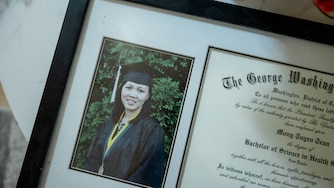To better understand the needs of dolphins and the complexities of their lives, I reached out to scientists and scientific institutions for interviews about the dolphin pod at the National Aquarium, which is apparently an incredibly taboo topic for marine biologists.
Dr. Michael Moore, a senior scientist at the Woods Hole Oceanographic Institution and the director of its Marine Mammal Center claimed a lack of expertise. When pressed, and asked to recommend a more suitable expert, he replied, “I’m trying to politely say I don’t want to talk about this topic. Or background for it. I have not followed the details, there are no easy answers, and I don’t want to discuss it. Thanks for your understanding. It’s easier to ignore such requests than be polite and reply.”
Dr. Randall Wells is the director of the Chicago Zoological Society’s Sarasota Dolphin Research Program in southwest Florida, and the chair of the Dolphin Biology Research Institute, and arguably knows as much about dolphins as any person in America.
When reached, he hurried off the phone saying he was in a meeting. Some days later, an email arrived from Sondra Katzen, a spokeswoman for the Chicago Zoological Society, which oversees the Sarasota Dolphin Research Program. She wrote: “We do not comment on policies, protocols, or decisions involving animals at other facilities. Because Dr. Wells and his colleagues are staff members of the Society, I’m sorry, but they will not be able to comment on National Aquarium’s dolphins.”
Next up: Trevor Spradlin, marine mammal biologist, and deputy division chief with the NOAA, the National Oceanic and Atmospheric Administration. He once took part in a study in the 1990s documenting behavior of captive dolphins employed in “swim with dolphins” attractions, according to the NOAA website. After a promising opening exchange, his spokespeople informed me that “Trevor does not believe he is the appropriate expert to assist you.”
None were willing to entertain even general questions about dolphins, wild or captive, once they got wind the National Aquarium’s dolphins were the focus of the story. After being shunned and ghosted by much of the dolphin scientific world, I finally found a willing expert: Naomi Rose, a marine mammal biologist who works for the Animal Welfare Institute.
She is also on the board of The Whale Sanctuary Project, an effort to create a 100-acre enclosed seaside home for captive whales in Port Hilford Bay, Nova Scotia. It too would be the first of its kind. Rose has decades of expertise with orcas and dolphins. And just as importantly, she has decades of experience with scientists.
“They don’t want to get involved in the debate about the public display of dolphins,” she said. “It’s an extremely controversial issue in the scientific community, and whether or not they work with dolphins, they’re going to be extremely nervous saying anything about the issue.”
The discomfort comes mostly from the fact captivity has been part of scientific research for a long time. For scientists to question the ethics of captivity is to indict the heroes and giants who came before them, Rose said.
Among them is Kenneth Norris, a pioneering marine mammal biologist and conservationist who was one of the first scientists to understand how dolphins used echolocation. He also founded SeaWorld in the 1960s with three of his fraternity brothers at UCLA, and before that was curator at Marineland of the Pacific, the largest marine park in the world when it opened in 1954. Both facilities featured orcas and dolphins who performed tricks. To distinguish themselves from circuses, marine park operators emphasized the conservation component of their institutions.
“The main purpose was to entertain people so they would care about these animals,” Rose said. “And of course, it made money.”
“It’s not an insult to Ken Norris, whom we all love and revere,” she said. “He didn’t know any better. None of us did. We didn’t know how intelligent they are, how far ranging they are. But if you talk about this issue too loudly like I do, you get grief.”
Explaining the seemingly tender nature of her otherwise highly rational peers, she said: “Scientists are people too. They’ve got egos, they’ve got pride, they’ve got investment. There’s sexism, there’s politics. The politics within science are dreadful.”
Some of her peers chastised her for questioning the scientific orthodoxy and going off what they perceived as the animal-rights deep end.
“It just pissed me off, so I doubled down,” she said. “That’s my personality.”




Comments
Welcome to The Banner's subscriber-only commenting community. Please review our community guidelines.